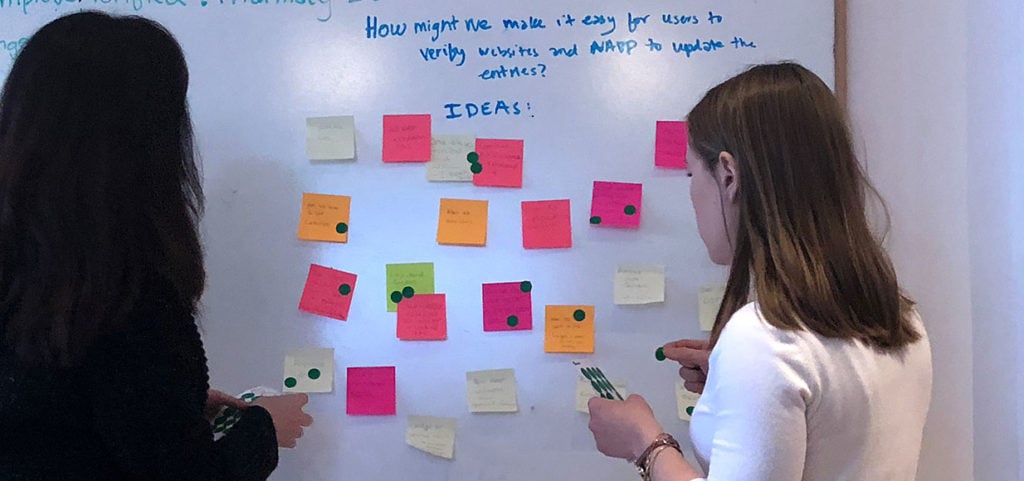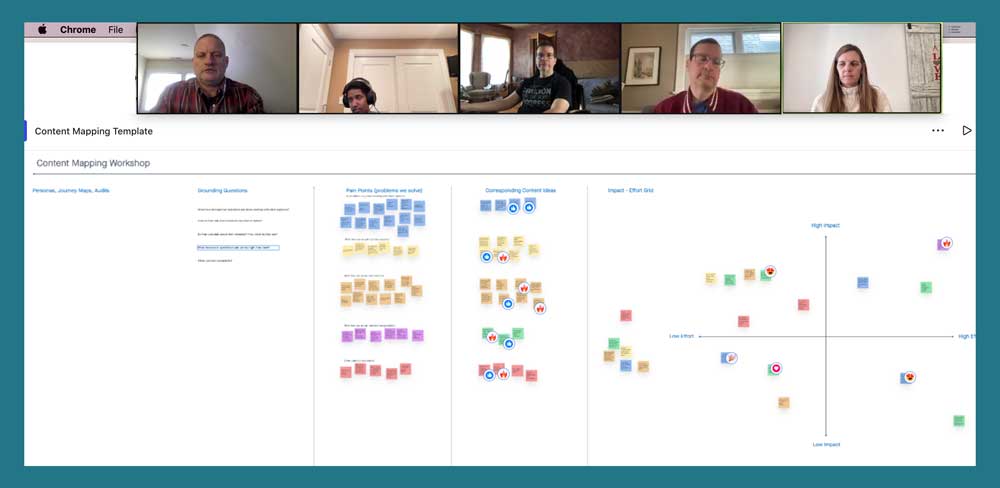RFPs: Not a Sustainable Business Practice

In this post, we explore how RFPs can set up large, complex projects for failure. We also uncover why RFPs are not a sustainable business practice and share several more equitable alternatives to finding a vendor for your next project.
Transitioning our economy to regenerate ecosystems, improve communities, and work more equitably for all people requires a wholesale redesign of traditional business processes and practices. One low-hanging task that any organization can take on is to reconsider its relationship with RFPs—the Request for Proposal.
The Problems with Requests for Proposals
RFPs—and the documents that arise from them—often play a big role in project failure. Many organizations are still stuck using this outdated business practice that often goes against the best interests of all stakeholders:
In order to successfully execute a long and complicated project we need tons of approved documentation, project specifications, and a binding contract up front.
But it doesn’t have to be this way. By operating with a shared understanding of common goals and embracing uncertainty, you can create project success in a world without the RFP—while also bringing your project in on time and under budget as well.
How RFPs Undermine Project Success
Organizations that distribute RFPs want to minimize risk. We get it. Large projects—especially website redesigns and digital product builds—are notorious for going over budget or taking longer than expected. Also, there are many crappy vendors out there who oversell their capabilities (and often underdeliver too). It makes sense that any organization wants to avoid this headache and find a good agency fit.
However, in the name of minimizing risk, these organizations also place unnecessarily rigorous and legally-binding constraints on projects that undermine the long-term viability of both the project and their relationship with a chosen vendor. In extreme cases:
- Organizations lose huge amounts of money
- Vendors go out of business
- Lengthy, expensive legal battles ensue
The reality is that RFPs are not a sustainable business strategy for either the organizations that issue them or the agencies that respond. Let’s explore why.
Why RFPs are Not a Sustainable Business Practice
In its simplest form, sustainable development means meeting present needs without compromising the ability of future generations to meet their own needs. Right away, many RFPs conflict with this idea:
- How can you possibly guarantee long-term success for all stakeholders through the exchange of a few documents?
- What makes project risk shared and equitable when one party transfers all risk to another through said documents?
- Sustainable digital transformation is all about resilience and continuous improvement while RFPs force you to set firm guidelines for the ‘definition of done’.
Sure, RFP disciples will claim that their documents are simply the beginning of a negotiating process. However, they also often frame RFPs as legally binding by including an exhaustive list of ‘terms’. For a response to be accepted, vendors must agree to an RFP’s terms wholesale.
To be realistic, most service firms won’t invest in legal services for projects they have no guarantee of winning. Thus begins the cycle of risk.
Six Important RFP Lessons Learned
In a nutshell, RFPs can actually increase risk rather than decrease it. With this in mind, here are six important lessons we learned on our journey to improve customer relationships while reducing the number of RFPs we respond to.
1. RFPs Waste Time
Time makes up your life, so wasting it is actually a slow form of suicide.
— Jeff Sutherland, author of Scrum: The Art of Doing Twice the Work in Half the Time
It isn’t efficient to spend so much time documenting the entirety of a project up front, especially when most specs will change as each party learns more about what success looks like. When it comes to project execution, unpredictability is the name of the game.
The Agile Manifesto states:
Agility is all about trusting in one’s ability to respond to unpredictable events more than trusting in one’s ability to plan for them.
This is a big mindset shift for many. To risk-averse, command-and-control organizations, agility can present an often existential threat. Yet VUCA—volatility, uncertainty, complexity, and ambiguity—defines the modern business environment, especially in the face of climate change and technological disruption.
Pamela Meyer, author of The Agility Shift: Creating Agile and Effective Leaders, Teams, and Organizations says that in reality preparing is much more effective than planning.
The purpose of preparing is to develop readiness for the unexpected, rather than solely to execute a plan…with a core focus on preparing, all participants [in the process] do more than adapt to change…[they] leverage its opportunities for innovation.
In other words, creating exhaustive project specs up front—especially before any contracts are awarded—is an inefficient use of resources. Often, these specs are wrong or based upon assumptions that haven’t yet been validated or refuted.
Defining Specs in a Vacuum
More importantly, RFPs not only waste time for the vendors who respond to them, but for the clients who create them as well. It is admirable to spend time fleshing out project requirements. However, clients don’t often have enough expertise to effectively create accurate specs. It is a far more effective use of time to do this together with your chosen vendor.
Some clients hire consultants to assist in the RFP process. However, collaboration and knowledge transfer are required to get any vendor up-to-speed. These clients are, in effect, paying twice for the same work. Which brings me to my next point…
2. RFPs Waste Money
The illusion is that RFPs improve efficiency, when in reality they create a cumbersome process that actually constrains all parties’ ability to make new discoveries and adapt along the way. Tied to a plan, organizations actually cut themselves off from the most important cost-saving strategy of all—continuous learning and innovation.
— Pamela Meyer
Here is Canadian RFP antihero Cal Harrison’s three minute take on why responding to RFPs is a huge waste of money:
It’s my best guess that in Canada each year we jam about $5 billion worth of wasted time and effort into our economy because of these inefficient RFP processes.
— Author and TedX speaker, Cal Harrison
If Canada alone wastes $5 billion each year in RFP responses, imagine how much time and money are wasted around the globe on the same thing. According to Deloitte Insights, the service sector, where most RFPs are born, accounts for up to 74% of GDP in high-income countries and up to 57% of GDP in low- and middle-income countries.
Considering that there are millions of service agencies across industries and around the world, it is easy to see how the amount of time and money wasted on RFP responses each year could be astronomical. Now that’s a broken system!
What’s more, RFP responses carry hard costs for firms that respond to them. Whether they win or lose the bid, those costs need to be covered somehow. This can put an undue financial burden on the firm’s other clients.

3. RFPs Undermine Mutual Trust
Let’s say your organization chooses a vendor based on their RFP response and manages to get through the time-consuming contract negotiation process. What next?
Now, both parties are contractually obligated to deliver on whatever is in that contract. However:
- What if you learn something new during the project that will drastically alter its outcome?
- Or maybe you learn that customers don’t actually want the feature or product you’ve already contracted a vendor to build.
- How do you prioritize new feature ideas under a fixed scope, fixed budget, fixed timeline scenario? Do you really want to hear ‘sorry, not in scope’ whenever a new idea arises? Because that’s what will happen.
If your Statement of Work (SOW) is tied to a contract, you often have little flexibility in these scenarios. Over time, frustration builds on both sides because each party isn’t getting what they need for success. Eventually, trust breaks down.
It is also unrealistic to expect that you can define a project’s entire scope through a few phone calls and some shared documents before turning in a proposal. This is a common—and very problematic—RFP scenario.
Most importantly, there is no opportunity to collaborate or build trust in this arrangement. How will your team know if they’re going to trust or enjoy working with this new vendor based on these few interactions?
RFPs and Intellectual Property
What’s more, some organizations will require that the issuing company own all the proposal responses it receives. In other words, the company can pick and choose the best ideas it received (for free) then award a contract that includes these ideas to the lowest priced bidder.
This is just bad business all around, not to mention ethically questionable.
Prioritizing Collaboration to Build Trust
Conversely, starting projects off with mutual collaboration in an open environment allows everyone involved with the project to create consensus and set expectations. This engenders mutual trust, which ultimately reduces risk better than any well-worded contract can.
If our clients are willing to boldly go, arm-in-arm, into the unknown with an understanding that we’ll solve problems and address challenges together, we’re all in. Sign us up.
However, if they only seem interested in micromanaging specs and extensive up-front documentation, we’re going to respectfully decline the opportunity to work with them.
4. RFPs Put Unreasonable Financial Restrictions on Projects
We don’t know our budget. We want you to tell us what it should be.
— Common client response to budget questions
If you’re inexperienced and unsure what your project should cost, that’s understandable. However, the cat-and-mouse game of dancing around a project’s ‘real’ budget is counter-productive for everyone.
Many vendors—Mightybytes included—won’t pursue opportunities where budget parameters aren’t clearly defined. Be clear about your budget from the get-go. This sets the tone for honesty and transparency throughout the relationship. Everyone will appreciate this in the end.
Plus, if both parties agree to shared goals early on and use a target budget and timeline as their North Star, discussions about what to do if project parameters shift become much easier.
5. RFPs Favor Cheap, Ineffectual Solutions
Lowest cost is widely recognized as the poorest criterion for service selection when quality and professional creativity are sought…Nobody willingly chooses a surgeon based upon a doctor’s willingness to perform an operation most cheaply.
— Wikipedia entry for Qualifications-Based Selection (see below)
Next, many RFPs—especially those from government agencies and (sometimes) nonprofits—state outright that the lowest bidder will win the contract. This is problematic for many reasons:
- Inexperienced vendors will often make claims they cannot deliver on just to win the work. Meanwhile, inexperienced clients may not know the difference.
- Seasoned vendors—who might have exactly the experience you need to successfully execute your project—may get priced out of consideration, or worse, won’t submit a bid at all.
- Considering the vast number of unknowns that typically exist before a project even starts, lowest price consideration is risky unless the chosen vendor has a proven track record of delivering similar projects under similar constraints. Even then, for all the other reasons mentioned in this post, choosing vendors based on lowest cost isn’t smart.
As we mentioned above, the process of knowledge transfer is ongoing. Embrace uncertainty as part of your project from the start and share your budget up front. An experienced vendor will know how to work with these parameters.
Definition of ‘Done’
More importantly, digital products are never done. They require ongoing maintenance and good product management practices to reduce risk and increase value over time.
However, as we established earlier, RFPs define completion requirements before the project even gets off the ground, despite the fact that most project scopes change as teams learn new things. This can instill a false sense of security in project stakeholders.
While this happens less frequently than in the past, it is still a relatively common occurrence that an organization doesn’t manage or maintain its digital products in any meaningful way…until said product gets hacked or otherwise goes offline. Then it’s a hair-on-fire emergency.
Depending on warranty terms, this scenario could prove challenging for either organization.
To summarize, defining success based solely on lowest price sets up a race to the bottom for your project and the industry overall. Who wants that?
6. RFPs Undermine Equity
Finally, as a nonprofit board member and agency owner, I’ve viewed RFPs from both the issuer’s and recipient’s perspectives. Once an RFP is complete, what’s the first thing an issuing organization will do to find prospective firms? Ask their network for referrals.
While this may seem useful, it often produces homogenous responses. Unfortunately, this process can exclude firms owned by Black, Indigenous, or People of Color leaders, members of the LGBTQ+ community, women, and others.
Diverse stakeholders produce better results. Instead, organizations searching for vendors should look further afield, beyond their own networks, to find prospective partners that bring diverse perspectives to their projects. Here are just a few directories to get you started:
- NGLCC – Find an affiliate chamber for local LGBTQ+ suppliers or use the Everywhere is Queer Map
- The National Minority Supplier Development Council’s MBE Search page
- Women Owned Business Directory
- The Veteran-Owned Business Directory
- Native Knot’s Indigenous-Owned Business Directory

What are More Sustainable Alternatives to RFPs?
How then do we address all these problematic issues that RFPs present? Consider the following options below.
Qualifications-Based Selection (QBS)
QBS has proven that buyers get better outcomes and greater value by excluding price as an evaluation criteria when hiring a professional services firm…
— QBS Canada
In qualifications-based selection (QBS), which was established by the U.S. Congress as part of the Brooks Act in 1972, cost is not a factor when assessing vendor hiring decisions. Rather, vendors are chosen based on their qualifications and ability to prove they have tackled similar challenges.
This does not mean that service fee negotiation is removed from the process. It just means that negotiation happens after the vendor is selected and before final contracts are drawn up.
However, qualifications-based selection is not without challenges:
- It can be difficult for new or inexperienced businesses to get a much needed foothold into the selection process.
- Some organizations fold an RFP into this process, which negates the advantage of taking this approach in the first place.
While not a perfect answer, basing the selection criteria on qualifications and ability to execute versus budget and timeline can yield better results.

Product Roadmapping
Your product roadmap is the prototype for your strategy.
— Product Roadmaps Relaunched, O’Reilly Media
Up front product roadmapping engagements provide project stakeholders with a low-risk way to define key parameters and build consensus in a collaborative setting. This sets large projects up for shared success.
At Mightybytes, we bill these engagements separately from project fees and don’t require contracts to run them. Postponing contract negotiations until after we know more about the project helps us get started quickly, which is especially useful for tight project timelines.
Also, we work with clients to identify an inclusive group of stakeholders to enlist in decision-making processes. This reduces risk for all parties and sets the tone for a mutually beneficial, trust-based relationship.
Does this mean we’re just replacing extensive up-front documentation with a different name? Absolutely not. Successful product roadmaps rely on three things:
- The process is grounded in collaboration and co-creation, which produces results faster.
- Product Roadmaps are lean, providing just enough information to set clear goals and manage expectations.
- Project stakeholders revisit the roadmap over time, making adjustments as new learning occurs.
Whether you incorporate a full roadmapping engagement or not, in our experience, up front, paid discovery processes will make the difference between your project’s success or failure.
Master Services Agreements
Our most successful and long-term customer relationships—some of which span multiple decades now—are guided by Master Services Agreements (MSAs) rather than project-specific contracts. Sure, we still create Statements of Work (SOWs) for individual deliverables, but this approach is lower risk for all involved.
Under these arrangements, the MSA guides terms of the client-vendor relationship, such as:
- Who owns deliverables
- How payments are handled
- The best way to communicate and document changes
- And so on …
Large, complex projects are broken down into more manageable chunks under individual SOWs, each of which covers a component of the overall project. This allows for more flexibility while still maintaining legally binding terms between the organizations.
How to Make Your Next Big Digital Project More Sustainable
To achieve long-term, shared success between agencies and the organizations that hire them, consider the following advice when jumpstarting your next big project.
Advice to Vendors Considering RFP Responses
Agencies and other service providers, if you must respond to an RFP, consider these points before doing so:
- Budget & timing: Ask about budget and timing parameters during the first call or email exchange. This will save everyone a lot of time. Consider politely declining the opportunity if you can’t get clear answers or if you know you can’t effectively deliver under the financial parameters.
- Discuss uncertainty: Be clear about how you address project uncertainties and that your estimates are just…estimates. Better yet, provide ranges for each deliverable.
- Managing expectations: If you win the project, schedule regular, ongoing conversations with clients about budget, timing, and deliverables. Make decisions together and don’t be afraid to talk about the hard stuff.
- Shared success: Is the issuing organization invested in long-term, shared success based on mutual trust and respect? If not, move on. Simple as that.
- Spec work: Above all, don’t do spec work! It is unethical for potential customers to ask for it and you should remind them of this if they do.
- Business development: Finally, consider replacing or supplementing RFP responses with other business development avenues. Diversifying income sources is key to any service firm’s long-term success.
Advice to Organizations Issuing an RFP
Thinking about going down the RFP path? Consider the following:
- QBS: Hire vendors based on experience and qualifications instead of asking for extensive project specs and cost details up front (which is really just another version of spec work).
- Budgeting: Be upfront about project financial parameters. If both parties clearly understand shared goals—and the budget available to meet those goals—you can figure out how best to address project challenges together. Remember, a feature is an output, not an outcome.
- Discovery: Embrace product roadmapping or paid discovery workshops to define project specs with a chosen partner. This will increase your chances for shared success.
- Contracts: Consider the MSA approach mentioned above rather than restrictive contracts that leave little flexibility for new learning or changing parameters.
- Planning vs. preparing: Don’t over-plan. Things will always change. Embracing this going into your project will result in more successful outcomes.
- Contests: Finally, you shouldn’t disguise an ask for free or spec work as a contest, despite how tempting, engaging, or ‘fun’ that might seem. As noted above, asking for spec work is unethical.
Prioritizing More Sustainable Digital Projects
The RFP process goes back decades. Many industries have been slow to move away from using this outdated practice, despite their significant problems and inefficiencies.
For many years, RFPs were a crutch that Mightybytes relied on to shield us from the hard work of finding good clients and developing mutually beneficial, long-term business relationships. However, the amount of energy we redirected from answering RFPs to other areas of the business enabled us to build a stronger, more resilient company. This benefits all stakeholders.
Similarly, organizations that eschew RFPs for more collaborative and inclusive vetting processes will foster better relationships with their suppliers and increase their chances for long-term digital success.
Given this, might you see similar advantages to reconsidering RFPs at your organization? If so and you still have questions, feel free to drop us a line. We would be happy to chat.



